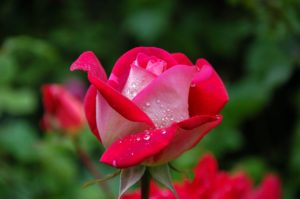
Be a Better Gardener, The Kindest Cuts
Demystifying rose care: knowing when and how to prune is key
By Thomas Christopher
Pruning rose bushes is a process that intimidates many otherwise confident gardeners. The problem arises, I think, from the kind of advice that is commonly offered by rose enthusiasts, “rosarians.” They tend to over-complicate the whole matter, laying down laws about how many stems you should leave on each bush, and how many buds you should leave on each cane. And in fact, how you prune your roses largely determines how well they bloom. Nevertheless, it doesn’t have to be complicated. If you keep just a few points in mind this task becomes an easy one, for really, pruning roses is no more complicated than pruning any other kind of shrub.
The first step is to determine the kind of roses you are growing. Do they bloom repeatedly throughout the summer like most modern roses? Or are they of an old- fashioned type that blooms just once in early summer, typically in June? The distinction is important because the different schedules of flowering reflect different patterns of growth. The modern, repeat-blooming roses produce flower buds on new growth, on branches produced in the spring immediately preceding the blooming season. The old- fashioned, once-blooming roses, in contrast, bear flowers only on shoots and branches that were produced during the previous year’s growth – on “old wood.”
This difference in patterns of flowering dictates different schedules of pruning. Pruning the modern, repeat-blooming roses in spring promotes lots of new growth and a better bloom over the subsequent summer. However, if you prune the old-fashioned roses in spring, you are cutting off the old wood which bears the flowers, which decreases these bushes’ bloom. The best time of year to prune old-fashioned roses is immediately after they flower, in early summer. This leaves them plenty of time to grow the new shoots that will bear the following year’s flowers.
Chances are what you are growing are roses of the modern, repeat-blooming type, as these are by far more common in catalogs and at garden centers. I like to prune these roses when the buds have just popped open in early to mid spring and the new shoots are about half an inch long. By waiting until then, I can tell which, if any, branches and stems were damaged by winter cold, because the buds on the damaged wood won’t open. Any winter-damaged branches I remove immediately, cutting them back to a spot a half inch or so above a healthy new shoot that is growing outward, away from the center of the rosebush – a cut of this kind encourages an open, spreading growth that makes for a healthier, more disease-resistant shrub.
After removing any winter-killed branches, I start to work on the rest of the bush. I typically begin by removing at the base any stems that have grown up through the center of the bush – remember, we want to encourage an open, spreading structure. I next target crossing branches, ones that rub against each other. I remove one of the two branches, typically cutting off at its base the weaker or ingrown branch.
As the final step in the pruning process, I usually shorten the remaining branches by about a third to encourage compact, sturdy growth. Again, I make these cuts a half-inch or so above an outward-facing new shoot. Having completed this step, I declare the pruning done.
The pruning process for the old-fashioned, once-blooming roses is much the same. I remove any winter-killed wood as the new shoots emerge in spring, but I wait until the bush has finished flowering in late June before I tackle the other steps.
One thing to keep in mind as you prune is that roses are very forgiving. They are relatively fast growing, so if you make a cut you regret, a healthy rosebush will soon replace the lost limb. This is especially true if you give your rose bushes a boost by administering the recommended dose in early spring of some fertilizer recommended on the label as a rose or shrub food.
Thomas Christopher is the co-author of “Garden Revolution” (Timber Press, 2016) and is a volunteer at Berkshire Botanical Garden. berkshirebotanical.org
Be-a-Better-Gardener is a community service of Berkshire Botanical Garden, one of the nation’s oldest botanical gardens in Stockbridge, MA. Its mission to provide knowledge of gardening and the environment through 25 display gardens and a diverse range of classes informs and inspires thousands of students and visitors on horticultural topics every year. Thomas Christopher is the co-author of Garden Revolution (Timber press, 2016) and is a volunteer at Berkshire Botanical Garden. berkshirebotanical.org.



